As Qatar’s World Cup ends it is time for truth: Fifa chose death and suffering
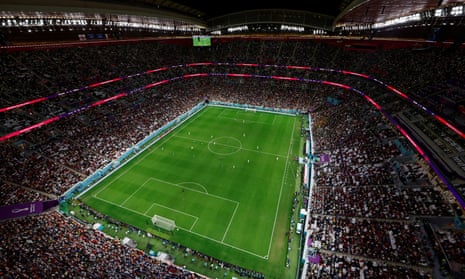
Fifa had options in 2010 and from the moment it made its bid decision, there was only one route from there to here
It was a different Gianni Infantino, a more pensive Gianni Infantino, a less alarmingly excited Gianni Infantino who addressed Hall 1 at the Qatar National Convention Centre on Friday morning.
This had been the scene of Infantino’s own defining moment just a month ago, his sacking of the temple, his Woodstock, his I have (a Very Peculiar) Dream. Brusquely late, Infantino was all business this time. “I am … happy … to be here,” he kicked off in a descending tone as though announcing the imminent execution of a colony of wasps. “Has this World Cup been a massive success?” he was asked from the floor. No, Gianni demurred very sightly. It had, in fact, been “an incredible success”.
Mainly he talked numbers: 3.27 million spectators; 1.7 million in the fan zone, a billion dollars in excess profits, $11bn in projected profits for next time.
He talked love, he talked joy, he talked (could this be a simple misunderstanding? Does he just need to look this phrase up?) about human rights. Above all Infantino was “very, very happy” at the progress of his World Cup. Put your hands together and rejoice, cheer, be thankful. Rejoice, even though your name is death.
Because the fact is some numbers were missing from Infantino’s podium notes; some usefully vague numbers that feel as if they are now on their way to being buried in plain sight.
The total number of migrant worker deaths during the 12-year cycle of Qatar’s World Cup has oscillated from three to 6,500, from 400 to 37. The New York Times reported just before the tournament that Nepal had calculated 2,000 deaths, including 200 suicides, a genuinely heartbreaking detail, albeit one that must, as ever, be degraded by Qatar’s bizarre absence of hard data.
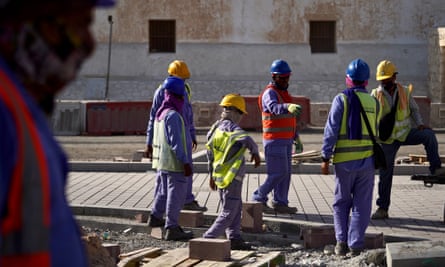
It has been a World Cup haunted by these ghosts, with a sense always of something just out of sight. And as Infantino ploughed on at the Convention Centre there was another spectre on stage, the outline of another oleaginous, bald Swiss on another stage, 12 years apart.
The fact is death and suffering were the inevitable collateral to this project from the moment Sepp Blatter read out the word “Qatar” in that weirdly strangled upbeat tone, crowded on his own stage by glad-handing power-brokers; and feeling, perhaps, through the lineups and posed smiles, that shadow already at his back, just out of shot, scythe clanking happily.
Do we have to say this again? Because what we have here is still an open case. The dots have not been joined. As Infantino drenched his audience in the familiar margarine of platitudes and half-truths, there was another sound in the hall, beneath the whirr of the cameras and the battering of keyboards. There it is, hiding in the silences: the sound of someone getting away with murder.
And this story will now move on. The last days of Qatar 2022 are the end of something, final notes to a cycle that began 12 years ago, bringing with it corruption, death, criminality and a building project as large as every other World Cup combined.
Little wonder the eyes of the world are a little glazed by now. Qatar 2022 has become an insoluble puzzle, a place where certainties collapse like sandcastles on the tide line, where nobody is really ever responsible for anything, where words stretch and lose their meaning, like the signs on the Doha fences say “AMA…….zing” and “TO….. gether”.
Infantino says this is the best World Cup ever. Mark Pougatch says the Ghanaians are colourful. Nasser al-Khalifa says stop mixing sport and politics. A rumour spread around Doha this week that the supreme delivery committee is planning to flip the tournament motto for the final weekend, from “Now is All” to “All is Now”, and the response was a weary shrug, a sense of, yeah, that seems about right.
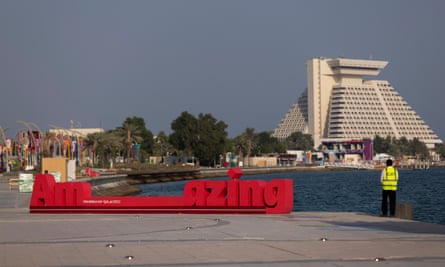
But there is still time for a moment of clarity. After 12 years of staring at this process one thing is undeniably clear. In the end this is all on Fifa. We can talk about Qatari law. We can discuss the Gulf war, colonialism, the decline of the west and all the other things that are bad in the world.
But the fact remains Fifa had choices here. And Fifa chose death and suffering. Look back with a clear line of sight and from the moment Fifa made its bid decision there was only one route from there to here. Define corporate manslaughter. What does that crime look or feel like as a chain of events? It is another question that has not been asked enough.
At which point the wind chimes tinkle one last time and we’re back in the drowned world of September 2010. It is worth remembering the details here. Three months before the bid vote, Fifa sent its Evaluation Committee, led by its chairman Harold Mayne-Nicholls of Chile, to assess Qatar’s fitness to host a World Cup. The evaluators were in Qatar from 13 to 17 September 2010, which doesn’t sound very long, even less so when a portion of it seems to have been spent playing football at the Aspire academy.
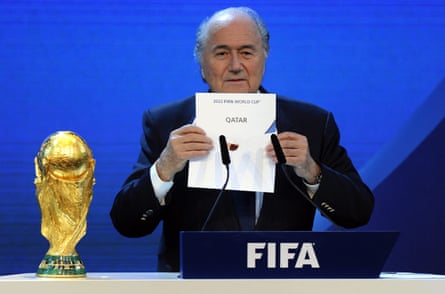
The report is fascinating. It acknowledges the extent of the work Qatar has left to do, while simultaneously averting its gaze from exactly how this is supposed to happen.
“The accommodation plan heavily depends … on significant construction … Significant development is planned for both the New Doha International Airport and the general transport infrastructure … The considerable number of infrastructure projects and volume of temporary event-time services both imply significant human resource requirements.” Are we getting anywhere yet? Is a picture emerging?
“Of the 64 accommodation solutions proposed, 54 do not yet exist … Of the 64 sites proposed 39 still need to be built. The remaining 25 sites are targeted for renovation.” Fifa’s committee considered stadium construction was a “medium risk”, team facilities “high risk (“most of the facilities do not yet exist”), with concerns too over transport infrastructure (“at present very little exists”). This was all duly noted by Mayne-Nicholls and fed back to his executive committee, albeit without a moment’s digging into who exactly was going to build all this stuff in a tiny nation.
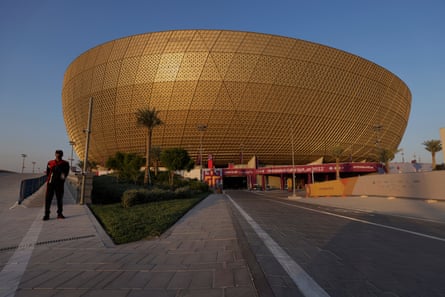
Not that any of this was a mystery. Five minutes on Google would have done the job for Fifa’s experts. As early as 2006 Human Rights Watch had published a report on kafala-type working conditions in the neighbouring emirates called Building Towers, Cheating Workers.
It notes the deliberately poor data on deaths and working conditions (sound familiar?). It records a Construction Week investigation that found 880 migrant workers had died in the UAE in 2004 alone, and an Indian official who registered 971 death cases in 2005 (the official total that year was 39).
Two years before the bid vote Amnesty International described similar poor working conditions in Qatar itself, including exploitation, non-payment of wages and lack of protection under the law. No secrets here. There is an entire library of this stuff.
And yet Fifa still asked Qatar to build it a World Cup, the equivalent of handing the council digger to the town’s most careless cowboy builder and promising to look the other way while he constructs a new school playground.
In his big opening speech Infantino described Qatar as “a child” who needed help. OK. That’s fine. But why, Fifa, did you ask a child to build you a €220bn World Cup?
At the time Mayne-Nicholls seemed, according to the Garcia report, more interested in trying to get his son and nephew a gig at the Aspire academy. But his report was also relatively damning, and he would go on to criticise publicly the Qatar decision. Fifa responded by banning him from football for seven years on some vague-looking charges which were later overturned by a baffled court of arbitration for sport.
This, then, was the framework for the decision. And so the touchpaper was lit. Doha tripled in size in a decade. Workers poured into the country, drawn either by higher wages or by their own poverty depending on how you want to look at it.
Qatar recruited specifically from nations worst hit by climate change, because, hey, desperation comes cheap. It set up what the New Yorker has described as “an ecosystem of plausible deniability”, with subcontractors upon subcontractors, a wall of silence, a lack of reporting, lack of representation, the failure even to conduct proper autopsies on its dead.
The reforms of the past few years suggest that Qatar has been willing to bend its rules just a little to get this thing done. And yet no pressure was exerted, no conditions applied, no comeback in 10 years when you’ve moved on a bit further. Instead Fifa simply set a match under this process and turned its face away.
It is perhaps one reason there has been no progress on the compensation of workers. Even as Infantino was crowing over his excess profits on Friday morning Amnesty International’s head of economic and social justice, Stephen Cockburn, was calling on Fifa to move, finally, on the idea of a legacy fund.

“Gianni Infantino has announced that Fifa made $7.5bn from the 2022 World Cup cycle, more than $1bn more than expected. He also forecast Fifa to make in excess of $11bn over the next four years. Yet he offered nothing new to so many workers and their families who continue to be denied compensation for stolen wages and lost lives.”
It has been suggested part of Fifa’s reluctance to commit to this could be the fear of a potential admission of implied liability. Very few things are left to chance around here. At least, not the ones that matter.
And that chain of liability really does need to be tested. Fifa, with its oversight, its European address, its teams of experts and evaluators, chose this path in full knowledge of the consequences. Fifa is a corporate person. It can be called to account. It is perhaps a surprise there hasn’t yet been a more concerted attempt to do so.
Instead other events will now swim into the foreground. As of Sunday evening a news cycle will end. The cartel of ghouls and goons that drove us here, the Blatter-Blazer-Warner golden generation, will fade deeper into the past. Nobody, will ever read the Garcia report, or care about handbags and mystery Picassos.
They’re selling discount Messi T-shirts at the Al Sadd Lulu saver centre. The strangest decade in the history of big corporate sport is coming to an end. And as things stand the real villains of this piece are still out there, wiping the blood from their palms as they stride out centre stage to preach about love and joy and spreading the message; and doing it all still in plain sight.

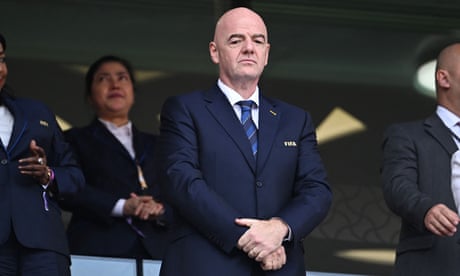

No comments:
Post a Comment